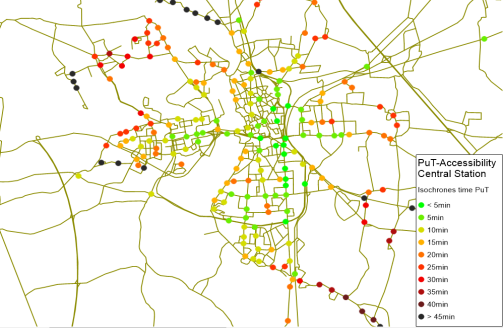PuT isochrones are used to analyze the accessibility of nodes, stops, stop areas, stop points and zones within a specified time interval. Accessibility is determined based on a timetable-based connection search. The search can be based on a departure or an arrival time interval.
In the first case, you determine all connections leaving from the network object selected within a certain time period, including an additional time span. This time span is entered after you have selected the departure period and refers to the time within which the connection must reach the destination.
In the second case, you analyze all connections that arrive at the network object selected within a certain time period and you enter a lead time. This is the time span directly before the arrival period specified and during which the connections must leave their starting point.
You can use nodes, stop areas and zones (or a combination of them) as reference points of PuT isochrones.
You can find the results of PuT isochrone calculation in the attributes Isochrones time PuT and Number of transfers PuT for nodes, stops, stop areas, stop points and zones. For each network object, the minimum journey time and minimum number of required transfers is listed.
|
Note: Please note that the values minimum run time and minimum number of required transfers may come from different connections, meaning that there is not necessarily a connection that includes both. |
The results depend on the time intervals specified. You can influence the calculation (except for the time reference), by limiting the search to active vehicle journey sections or by specifying a maximum number of transfers.
The following options are available for displaying PuT isochrones graphically in the Network editor:
- 2D drawing
The attributes Isochrones time PuT and Isochrones number of transfers PuT can be used in 2D to classify the accessibility intervals.
- Classified representation of nodes, zones, stops, stop areas and stop points
The attributes Isochrones time PuT and Isochrones number of transfers PuT can be used for a classified representation of one or several network object types.

Illustration 246: PuT journey time to destination: classified display of stops

